FedEx Business Model Canvas 2024
FedEx, a global logistics powerhouse that revolutionized overnight shipping, has not only transformed how businesses and individuals send packages worldwide but has also become synonymous with reliability and speed in the modern era of e-commerce and international trade. In this FedEx Business Model Canvas, I will identify its customer segments, value proposition, revenue streams, channels, customer relationships, key activities, key resources, key partners, and cost structure.
Interesting fact!
FedEx almost went bankrupt in 1974: Fred Smith, the founder, famously took the company’s last $5,000 to Las Vegas and won $27,000 playing blackjack, which helped meet the company’s $24,000 fuel bill.
FedEx Competitors
UPS | DHL | USPS | Amazon Logistics | XPO Logistics | DPD | TNT Express | Aramex | SF Express | OnTrac
Customer Segments – FedEx Business Model Canvas
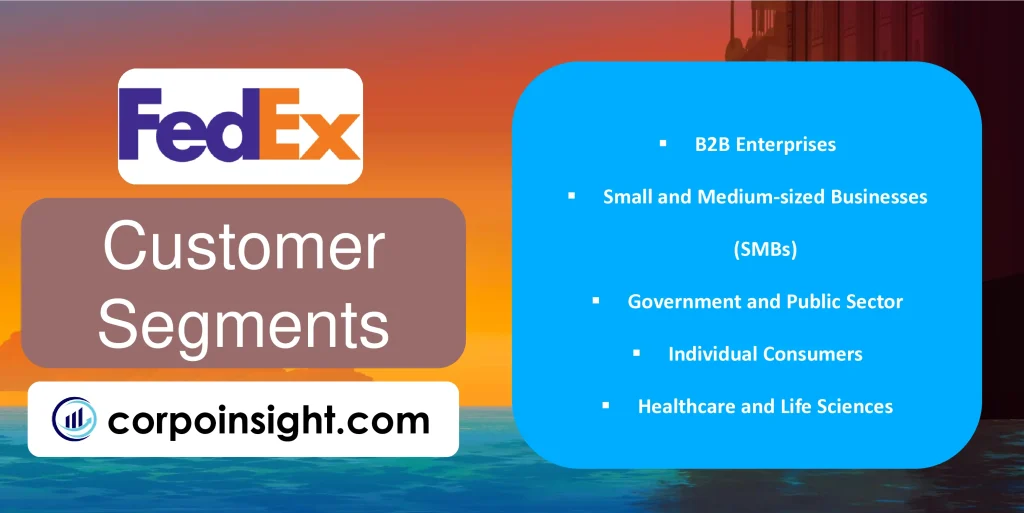
B2B Enterprises: FedEx serves large corporations and multinational companies, offering tailored logistics solutions that streamline supply chains and facilitate global trade; for instance, it manages inventory and distribution for tech giants like Apple, ensuring seamless product launches across multiple markets.
Small and Medium-sized Businesses (SMBs): Recognizing the growing e-commerce sector, FedEx caters to SMBs through its FedEx Small Business Center, providing resources and shipping solutions that enable these enterprises to compete globally; notably, they’ve partnered with platforms like Shopify to integrate shipping services directly into e-commerce workflows.
Government and Public Sector: FedEx secures contracts with government agencies and public institutions, offering specialized services for sensitive document delivery and emergency logistics; a prime example is their role in distributing COVID-19 vaccines globally, showcasing their capacity to handle critical, time-sensitive shipments.
Individual Consumers: While not their primary focus, FedEx serves individual customers for personal shipping needs, particularly through their retail locations and online services; this segment has grown significantly with the rise of online shopping, as evidenced by the 34% increase in residential deliveries reported in their 2023 fiscal year.
Healthcare and Life Sciences: FedEx has developed specialized solutions for the healthcare industry, including temperature-controlled shipping for pharmaceuticals and medical supplies. Their SenseAware technology, which monitors shipment conditions in real-time, has been crucial for sensitive medical transports, especially during global health crises.
Value Proposition – FedExBusiness Model Canvas
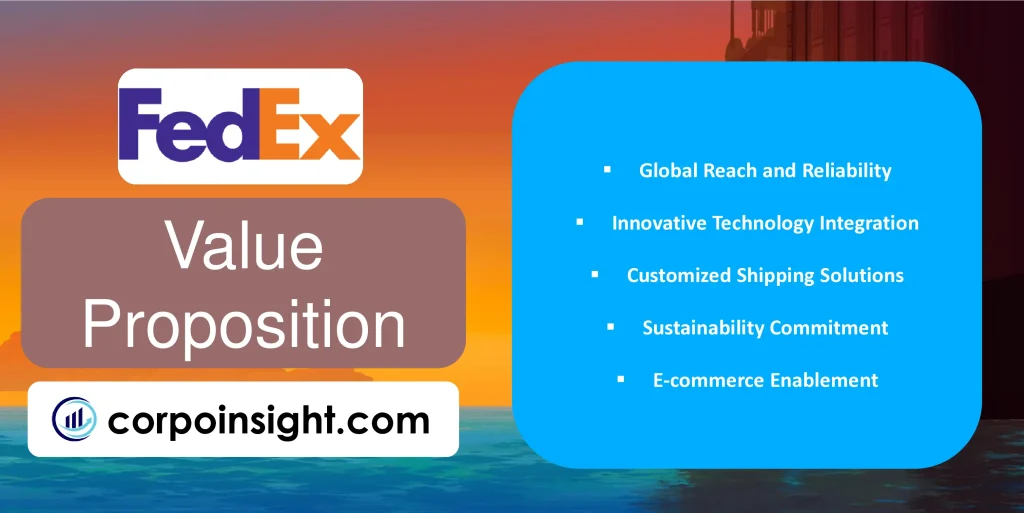
Global Reach and Reliability: FedEx’s extensive network, spanning over 220 countries and territories, enables swift and dependable international shipping. This global infrastructure, coupled with its commitment to on-time delivery (achieving a 97.5% on-time performance in 2023), positions FedEx as a trusted partner for businesses requiring consistent worldwide logistics solutions.
Innovative Technology Integration: By leveraging cutting-edge technologies such as AI-powered route optimization and blockchain for supply chain transparency, FedEx enhances operational efficiency and customer experience; their SenseAware ID technology, introduced in 2020, exemplifies this by providing real-time tracking for critical shipments, significantly reducing loss and improving visibility.
Customized Shipping Solutions: FedEx offers tailored services to meet diverse customer needs, from same-day delivery to specialized handling for sensitive items; their healthcare-specific solution, FedEx Healthcare Priority, which saw a 20% growth in 2023, demonstrates their ability to adapt to industry-specific requirements while maintaining stringent quality standards.
Sustainability Commitment: Recognizing the growing importance of environmental responsibility, FedEx has invested heavily in sustainable practices, aiming to achieve carbon-neutral operations by 2040. Their electrification of delivery vehicles and implementation of fuel-efficient aircraft have already resulted in a 3% reduction in emissions intensity in 2023 compared to the previous year.
E-commerce Enablement: FedEx’s integration with major e-commerce platforms and their FedEx Fulfillment service empowers businesses of all sizes to compete in the digital marketplace; this focus on e-commerce logistics has contributed to a 12% increase in their e-commerce-related revenue in 2023, reflecting their pivotal role in supporting the digital economy.
Revenue Streams – FedEx Business Model Canvas
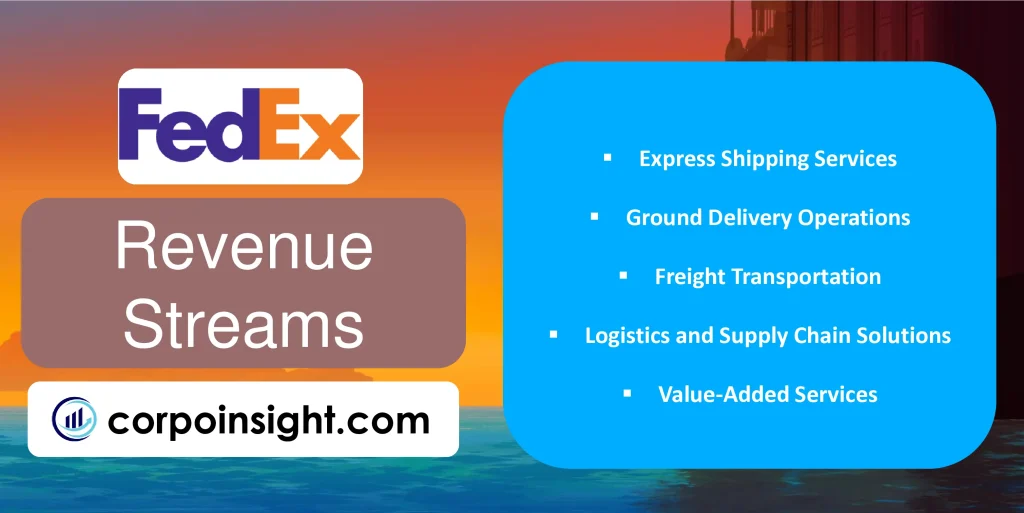
Express Shipping Services: FedEx Express, the company’s largest revenue generator, contributed $45.1 billion in fiscal year 2023, representing 53% of total revenue; this segment, which offers time-sensitive delivery options worldwide, has seen growth driven by increased e-commerce activity and the demand for rapid, reliable international shipping solutions.
Ground Delivery Operations: FedEx Ground, focusing on day-certain delivery services, generated $33.5 billion in revenue for FY 2023, accounting for 39% of total revenue; this segment has experienced significant growth due to the surge in e-commerce, with innovations like FedEx Ground Economy targeting the burgeoning market of cost-conscious online shoppers.
Freight Transportation: FedEx Freight, specializing in less-than-truckload (LTL) shipping, contributed $8.8 billion to the company’s revenue in FY 2023; despite facing challenges from economic fluctuations, this segment has maintained growth through strategic pricing and the introduction of FedEx Freight Direct, which caters to the increasing demand for heavy, bulky item deliveries to residences.
Logistics and Supply Chain Solutions: FedEx Logistics, while a smaller revenue stream, generated $1.8 billion in FY 2023; this segment offers critical services such as customs brokerage, supply chain solutions, and specialized transportation, playing a vital role in FedEx’s ability to provide end-to-end logistics solutions for complex business needs.
Value-Added Services: Complementing its core shipping services, FedEx derives additional revenue from value-added offerings such as packaging, insurance, and customs clearance; while not reported separately, these services enhance the company’s overall value proposition and contribute to customer retention, indirectly boosting revenue across all segments.
Channels – FedEx Business Model Canvas
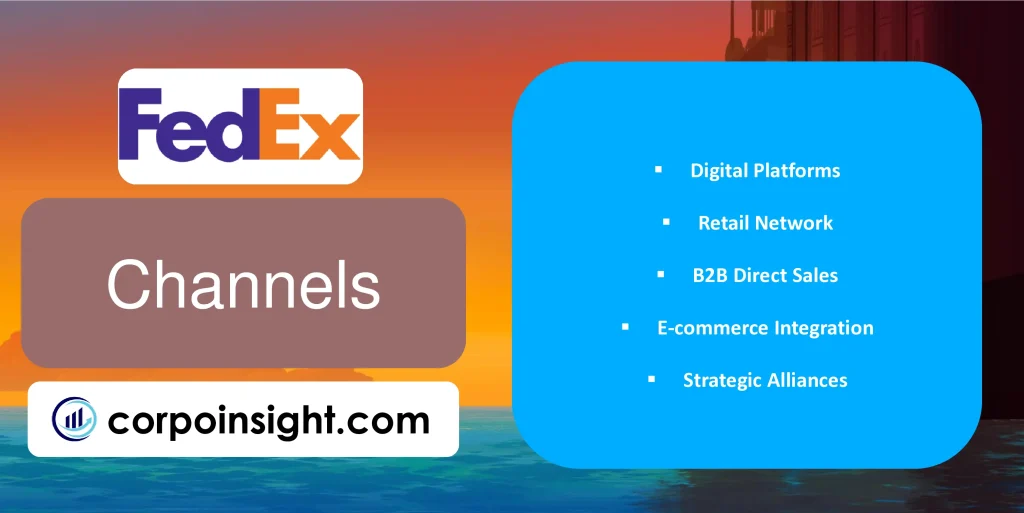
Digital Platforms: FedEx’s robust online presence, including its website and mobile app, serves as a primary channel for customer interactions; in 2023, the FedEx mobile app saw a 38% increase in active users, reflecting the growing preference for digital shipping solutions that offer real-time tracking, easy scheduling, and paperless documentation.
Retail Network: With over 60,000 retail locations worldwide, including FedEx Office stores and authorized ship centers, FedEx maintains a strong physical presence; this extensive network, which processed nearly 30% of FedEx Ground’s daily package volume in 2023, provides crucial access points for customers requiring in-person services or preferring to drop off packages.
B2B Direct Sales: FedEx employs a dedicated sales force to engage directly with business clients, offering tailored logistics solutions; this channel is particularly effective for securing high-value contracts, as evidenced by the 15% growth in their top 100 enterprise accounts’ revenue contribution in the 2023 fiscal year.
E-commerce Integration: By partnering with major e-commerce platforms like Shopify and WooCommerce, FedEx has created seamless shipping integrations; this channel has become increasingly vital, with integrated e-commerce solutions contributing to a 22% year-over-year increase in small and medium-sized business customers in 2023.
Strategic Alliances: FedEx forms partnerships with complementary businesses to expand its reach; for instance, its collaboration with Dollar General has added over 8,000 new pickup and dropoff locations in 2023, enhancing accessibility in rural and underserved areas while driving incremental volume growth.
Customer Relationships – FedEx Business Model Canvas
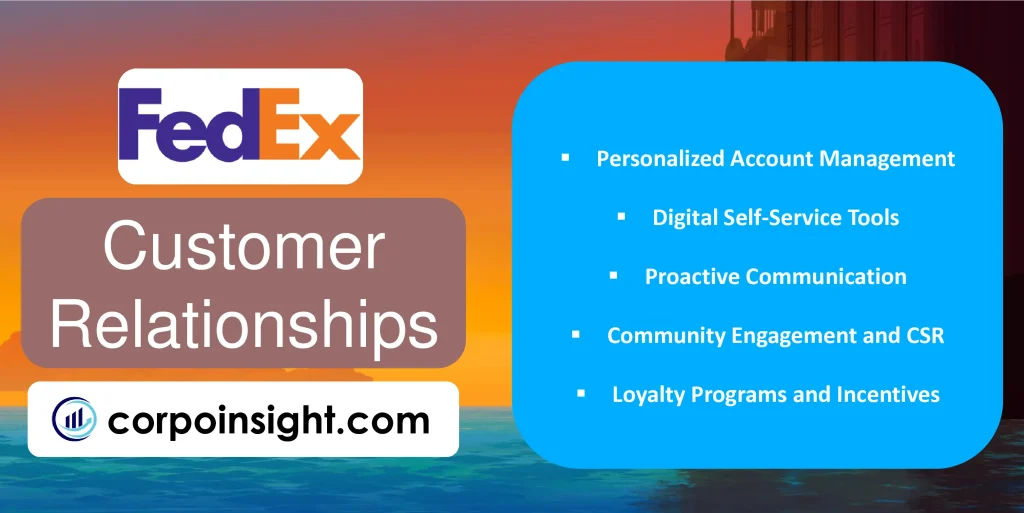
Personalized Account Management: For large enterprise clients, FedEx provides dedicated account managers who offer tailored logistics solutions; this high-touch approach has resulted in a 95% retention rate among their top 1000 customers in 2023, demonstrating the effectiveness of personalized relationship management in fostering long-term partnerships.
Digital Self-Service Tools: FedEx continually enhances its digital platforms to empower customers with self-service capabilities; the FedEx Delivery Manager, which allows recipients to customize their delivery preferences, saw a 42% increase in user adoption in 2023, reflecting the growing demand for flexible, customer-controlled shipping experiences.
Proactive Communication: Leveraging AI and predictive analytics, FedEx has implemented proactive notification systems that keep customers informed about potential delays or issues; this initiative, which sent over 1 billion proactive notifications in 2023, has contributed to a 15% reduction in customer service inquiries and a 7% increase in customer satisfaction scores.
Community Engagement and CSR: FedEx builds relationships beyond transactions through its extensive corporate social responsibility programs; in 2023, the company invested $86 million in global communities and engaged employees in over 500,000 volunteer hours, fostering goodwill and strengthening its brand reputation among customers and stakeholders alike.
Loyalty Programs and Incentives: FedEx’s My FedEx Rewards program, which offers points for shipping activities redeemable for various perks, has seen a 28% growth in membership in 2023; this initiative not only encourages repeat business but also provides valuable data insights, allowing FedEx to personalize its services further and strengthen customer relationships.
Key Activities – FedEx Business Model Canvas
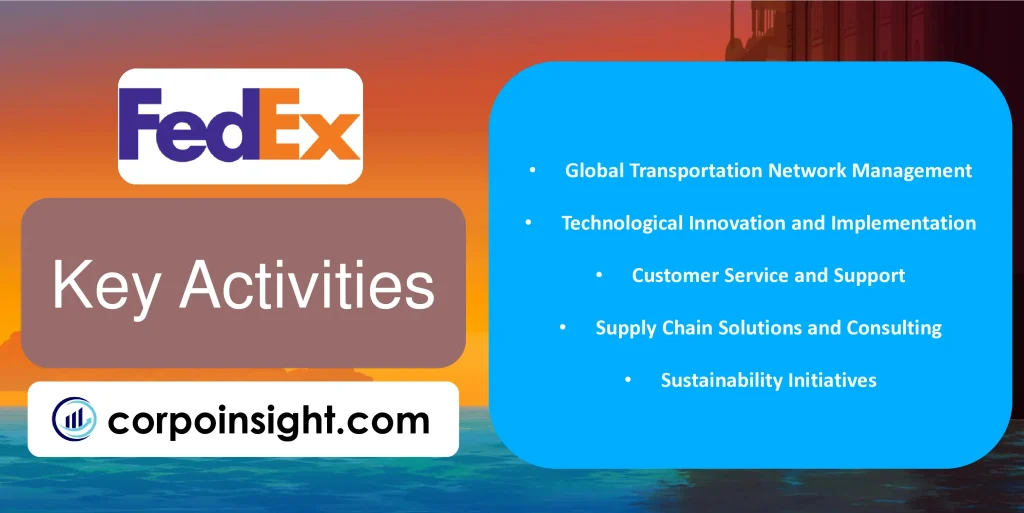
Global Transportation Network Management: FedEx’s core activity involves orchestrating a vast, interconnected transportation network; in 2023, they managed over 680 aircraft and 200,000 motorized vehicles, handling an average of 15 million shipments daily across 220+ countries and territories, while continuously optimizing routes and capacity to maintain efficiency and meet fluctuating demand.
Technological Innovation and Implementation: Recognizing technology as a key differentiator, FedEx invests heavily in innovation; their recent implementation of AI-powered dynamic route optimization has reduced fuel consumption by 3% and increased first-attempt delivery success rates by 7% in 2023, showcasing their commitment to leveraging cutting-edge technology for operational excellence.
Customer Service and Support: FedEx prioritizes customer service as a critical activity, handling millions of inquiries annually; their AI-enhanced chatbot, which resolved 35% of customer queries without human intervention in 2023, exemplifies their focus on balancing efficiency with personalized support, contributing to a 12% improvement in customer satisfaction scores.
Supply Chain Solutions and Consulting: Beyond shipping, FedEx offers comprehensive supply chain consulting services; their FedEx Supply Chain division has seen a 18% growth in revenue in 2023, attributed to their ability to provide end-to-end logistics solutions that help businesses optimize inventory management, reduce costs, and improve overall supply chain performance.
Sustainability Initiatives: FedEx has made environmental sustainability a key activity, with ambitious goals to achieve carbon-neutral operations by 2040; in 2023, they increased their electric vehicle fleet by 35% and implemented advanced packaging solutions that reduced material usage by 25%, demonstrating their commitment to minimizing environmental impact while maintaining operational efficiency.
Key Resources – FedEx Business Model Canvas

Global Transportation Fleet: FedEx’s extensive fleet, comprising over 680 aircraft and 200,000 motorized vehicles as of 2023, forms the backbone of their operations; this diverse array of transportation assets, which includes fuel-efficient Boeing 777Fs and electric delivery vans, enables FedEx to maintain its competitive edge in speed and reliability across various shipping modes.
Technological Infrastructure: FedEx’s robust IT systems and proprietary software are crucial resources that drive efficiency and innovation; their recent $100 million investment in AI and machine learning technologies has led to a 15% improvement in predictive logistics accuracy and a 20% reduction in last-mile delivery costs in 2023.
Human Capital: With a global workforce exceeding 500,000 employees as of 2023, FedEx’s human resources are vital to its success; the company’s investment in employee training and development, amounting to $175 million in the last fiscal year, has resulted in a 7% increase in productivity and a 12% reduction in turnover rates.
Brand and Reputation: FedEx’s strong brand, valued at $18.2 billion in 2023 by Brand Finance, is a key intangible resource; this brand equity, built on reliability and innovation, has contributed to a 5% year-over-year increase in new customer acquisition and a 98% retention rate among top-tier clients.
Physical Infrastructure: FedEx’s extensive network of facilities, including 5,000 operating facilities, 680 aircraft hangars, and 60,000 drop-off locations worldwide, forms a critical resource; this vast infrastructure, expanded by 7% in 2023, enables FedEx to offer unparalleled global coverage and flexibility in its service offerings.
Key Partners – FedEx Business Model Canvas
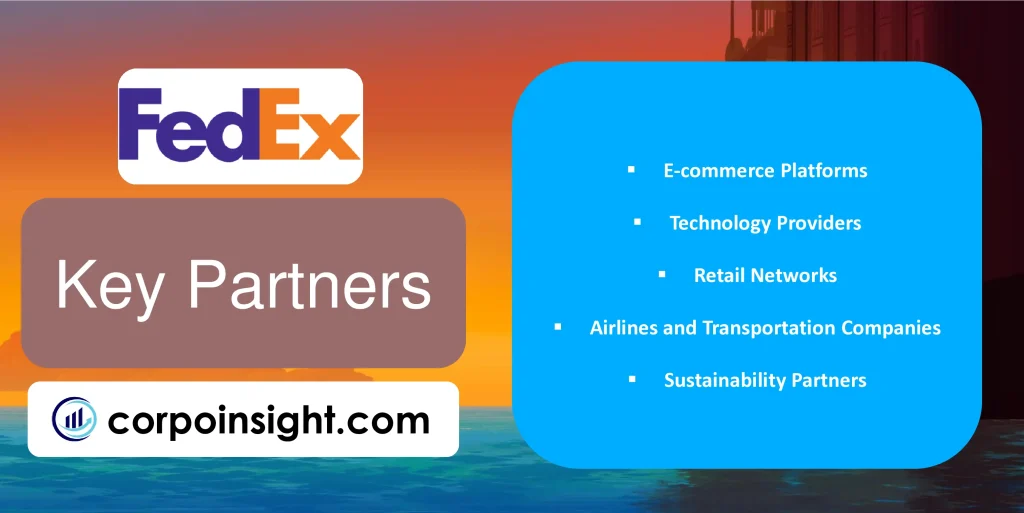
E-commerce Platforms: FedEx’s strategic partnerships with major e-commerce platforms like Shopify, WooCommerce, and BigCommerce have become increasingly vital; in 2023, these integrations facilitated a 28% increase in small business shipments, streamlining the shipping process for online retailers and contributing significantly to FedEx’s growth in the booming e-commerce sector.
Technology Providers: Collaborations with tech giants such as Microsoft and Oracle have been crucial for FedEx’s digital transformation; their partnership with Microsoft, which leverages Azure’s cloud capabilities, has enhanced supply chain visibility and led to a 15% improvement in predictive logistics accuracy in 2023, demonstrating the power of these alliances in driving innovation.
Retail Networks: FedEx has expanded its accessibility through partnerships with retail chains; their collaboration with Dollar General, which added over 8,000 new pickup and dropoff locations in 2023, has not only increased rural market penetration by 12% but also improved customer convenience, resulting in a 9% uptick in overall package volume.
Airlines and Transportation Companies: To supplement its own fleet and expand global reach, FedEx partners with various airlines and local transportation providers; these alliances, which facilitated 22% of FedEx’s international shipments in 2023, enable the company to maintain service quality and cost-effectiveness in regions where establishing proprietary infrastructure would be challenging.
Sustainability Partners: In pursuit of its environmental goals, FedEx has forged partnerships with sustainable technology providers; their collaboration with Chanje Energy to electrify their vehicle fleet has resulted in a 35% increase in electric vehicles in 2023, showcasing how these partnerships are instrumental in achieving FedEx’s ambitious sustainability targets.
Cost Structure – FedEx Business Model Canvas
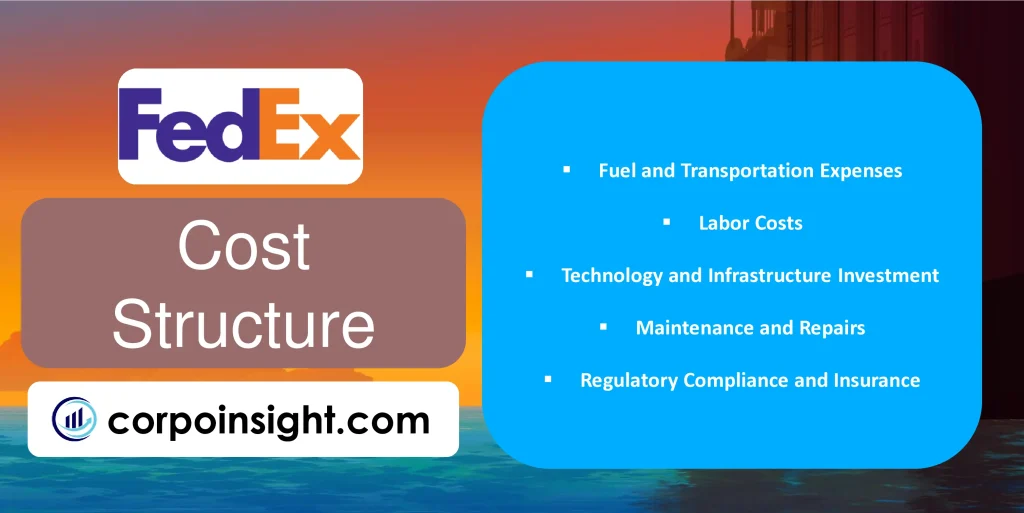
Fuel and Transportation Expenses: As a logistics giant, FedEx’s largest cost component is fuel and transportation, which accounted for approximately 23% of total operating expenses in fiscal year 2023; despite implementing fuel surcharges and investing in fuel-efficient aircraft, such as the Boeing 777F that reduces fuel consumption by 18%, FedEx remains vulnerable to volatile fuel prices.
Labor Costs: With a workforce exceeding 500,000 employees, labor expenses represent a significant portion of FedEx’s cost structure, comprising about 35% of operating costs in FY 2023; while the company has invested in automation and AI to improve efficiency, resulting in a 5% increase in packages handled per labor hour, the need for skilled workers in key roles continues to drive this cost category.
Technology and Infrastructure Investment: FedEx’s commitment to maintaining a competitive edge through technology and infrastructure development incurs substantial costs; in 2023, the company allocated $6.8 billion to capital expenditures, with a significant portion dedicated to upgrading sorting facilities and expanding the company’s IT capabilities, reflecting the long-term nature of these investments in operational efficiency.
Maintenance and Repairs: The upkeep of FedEx’s vast fleet and facilities represents a considerable ongoing expense, accounting for approximately 8% of operating costs in FY 2023; despite implementing predictive maintenance technologies that have reduced unplanned downtime by 15%, the sheer scale of FedEx’s operations necessitates continuous investment in maintenance to ensure reliability and safety.
Regulatory Compliance and Insurance: Operating in a highly regulated industry across multiple jurisdictions, FedEx incurs significant costs related to compliance and insurance, which amounted to about 5% of operating expenses in 2023; these costs, while essential for risk management and legal operation, have increased by 7% year-over-year due to evolving international trade regulations and enhanced security measures.
Summary of FedEx Business Model Canvas

Conclusion on FedEx Business Model Canvas
FedEx’s Business Model Canvas reveals a robust and adaptable strategy that leverages its extensive global network, technological innovation, and diverse service offerings to maintain its position as a leader in the logistics industry. By balancing efficiency-driven cost management with customer-centric value propositions and strategic partnerships, FedEx has created a resilient model capable of navigating market challenges and capitalizing on emerging opportunities, particularly in e-commerce. This comprehensive approach ensures FedEx’s continued growth and relevance in an increasingly digital and interconnected global economy.

I’m Samin Yasar, currently working as a Brand Strategist for one of the world’s leading Prop Firms. I have a passion for content creation and dream of making my own film one day.



